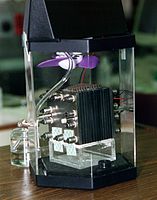
Photo from wikipedia
Abstract High-purity standards are required for hydrogen used in fuel cell vehicles. The relative abundance of contaminants is highly influenced by the production pathway. Hydrogen obtained from water electrolysis presents… Click to show full abstract
Abstract High-purity standards are required for hydrogen used in fuel cell vehicles. The relative abundance of contaminants is highly influenced by the production pathway. Hydrogen obtained from water electrolysis presents three main pollutants: Nitrogen, Oxygen and Water. Herein, the engineering and implementation of removal techniques in a commercial 50 kW alkaline electrolyzer are reported. The full system was characterized with various analytical techniques including gas chromatography and mass spectrometry. A reduction of contaminant levels compatible with ISO 14687:2019 standard was achieved. From cold start, 100 min of operation are required to reach the desired nitrogen levels. Oxygen was removed in one step with a catalytic converter. Drying of hydrogen was achieved by using an innovative vacuum assisted pressure swing adsorption system. Sub-ppm levels of water are obtained with a power consumption of only 0.5 kWh/kg H2 and 98.4% of product recovery.
Journal Title: International Journal of Hydrogen Energy
Year Published: 2020
Link to full text (if available)
Share on Social Media: Sign Up to like & get
recommendations!